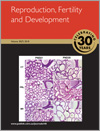Reproduction, Fertility and Development
Volume 30
Number 7 2018
During preimplantation development, the bovine embryo is free floating in oviduct and uterine fluids. We aimed to mimic the physiological conditions of the maternal environment in the present study by supplementing serum-free embryo culture medium in vitro with both fluids sequentially. The results revealed that low concentrations of oviduct and uterine fluids support early embryo development and improve blastocyst quality.
This study mainly explored the effects of nutrition on seasonal patterns of the ovine estrus cycle in the non-breeding season. Based on low or high nutrition levels, it was found that two nutritional factors (tyrosine and folic acid) were involved in the regulation of oestrous pathways during the anestrous season, and the GNAQ gene is an important regulatory hub between nutritional and photoperiodic regulation of seasonal breeding in sheep.
Activin C can delay the growth of mouse granulosa cell tumours, but little is known about its function in normal ovaries. This study shows that activin C protein is expressed in normal mouse and human ovaries, and can delay the development of abnormal follicles in mice lacking inhibin, but does not appear to alter normal follicle growth in the mouse. This study provides evidence of a role for activin C in the ovary.
Prostate development and function are altered by early postnatal exposure to prolactin imbalance. Prolactin modulation interferes with the determination of ventral prostate development and maturation through a mechanism of increasing the epithelial proliferative response and dynamics of cell differentiation. Changes in prostate morphophysiology after prolactin modulation could affect glandular function and the incidence of disorders associated with aging.
It is well documented that oocytes from super stimulated heifers are less competent compared to sexually mature cows. In this study, we characterized the changes in granulosa cells gene expression within the same heifers approaching puberty following ovarian stimulation. We found a lower level of signaling in: cell differentiation, inflammation and apoptosis, suggesting an insufficient support of luteinizing hormone during FSH withdrawal.
Ionomycin is a Ca2+-selective ionophore commonly used in assisted oocyte activation (AOA), to overcome failed fertilisation. We investigated the effect of external ionomycin and Ca2+, supplemented to the culture media during AOA, on activation efficiency and embryonic developmental potential, in both mouse and human oocytes. The demonstrated effect of commercial medium on the pattern of Ca2+ release and further embryonic developmental potential should be considered when applying AOA in the clinic.
In mammals, the success rate of oocyte activation is one of the main factors that influences the efficiency of parthenogenetic activation (PA) and somatic cell nuclear transfer (SCNT). In this study, a new oocyte-activated reagent, JNJ-7706621, was applied in the production of porcine PA and SCNT embryos and was found to improve in vitro developmental competence by suppressing the level of MPF.
Animal cloning is a very inneficient process in many mammalian species. The successful establishment of pregnancy is dependent on a controlled interaction between the developing placenta and the maternal immune system. We observed an altered expression of genes related to inflammation, growth and apoptosis in placentas of cloned sheep, which likely contribute to the placental dysfunction and fetal overgrowth observed in these pregnancies.
Thirty-nine metabolites, including 14 amino acids, were identified in the bovine oviductal fluid. Regardless of the cycle stage or ovulation side, lactate, myo-inositol and glycine were the most abundant metabolites. The fold changes in metabolite levels between stages or ovulation sides were less than 1.7 except for glucose-1-phosphate which was highly regulated across the estrous cycle.
Bats are excellent indicators of environmental quality and their reproduction is affected by climate change. This study highlighted the effects of body condition and seasonality on reproductive behaviour, demonstrating changes in the morphofunctional parameters of the testes between rainy and dry seasons.
Fertility loss is a major problem in roosters in the commercial poultry industry. The aim of the present study was to investigate the effects of orally administered d-aspartate on the reproductive performance of roosters. The findings reveal that the positive effects of d-aspartate are probably mediated via changes in gene expression and testicular histology. This study shows that dietary supplementation with d-aspartate is an easy and practical strategy to mitigate the reproductive loss in roosters.




